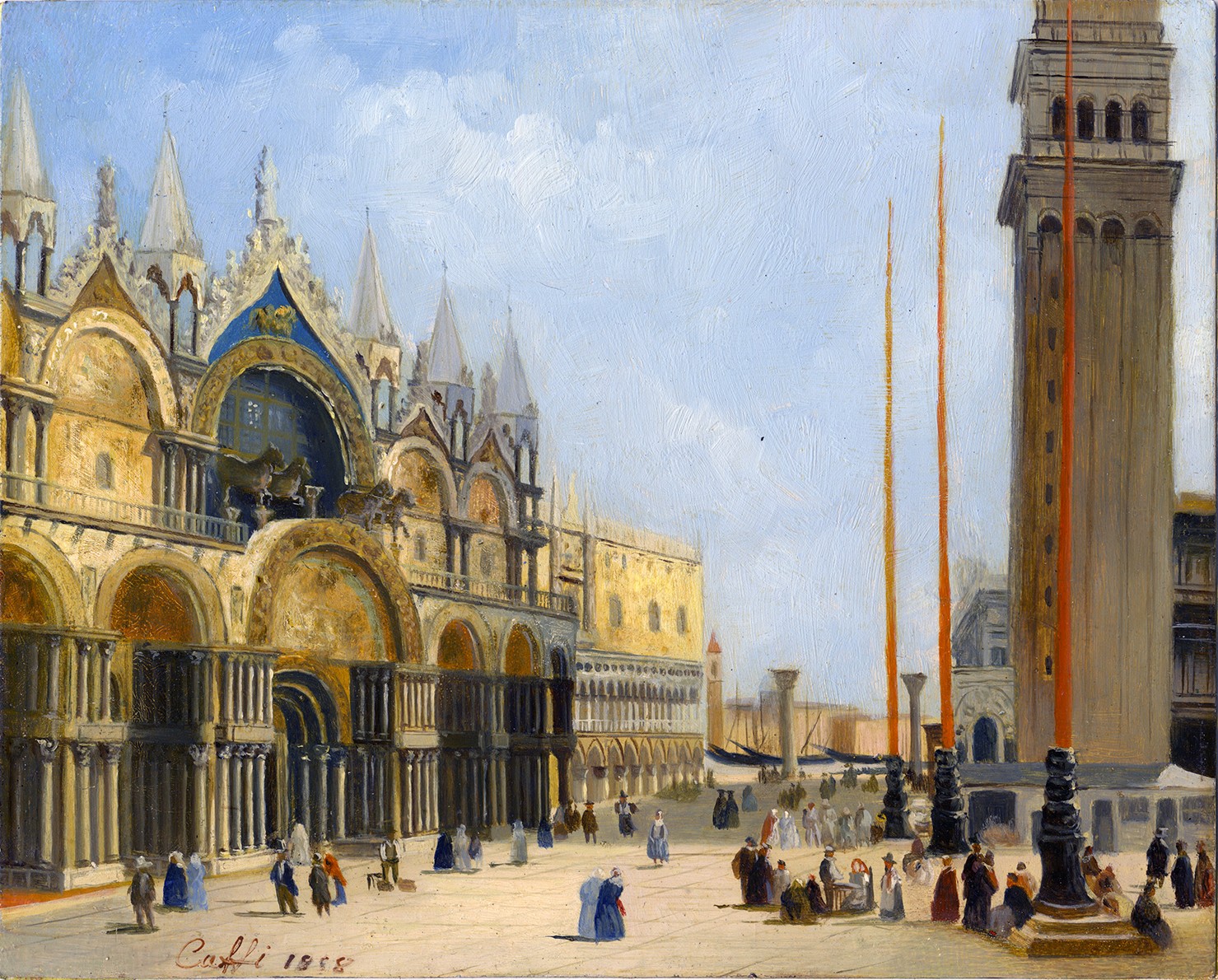Ippolito Caffi
(Belluno 1809 - 1866 Lissa)
Venice, San Marco, 1858
oil on copper, 19,8 x 25,2 cm (7.80 x 9.92 inches)
Ippolito Caffi
(Belluno 1809 - 1866 Lissa)
Venice, San Marco, 1858
oil on copper, 19,8 x 25,2 cm (7.80 x 9.92 inches)
Re: 864
Provenance: Private collection
Signed and dated:
Caffi 1858
The signature "Caffi 1858" in the bottom right-hand corner is undoubtedly coeval with the writing of the composition, thus underlining an autograph authorship that is also and above all certified by the stylistic reasons that will be explained later. The work is painted in oil on a metal support, most likely a copper plate of the type usually used for etchings. This is unique in Caffi's production, even if choices of this type were far from unusual among his contemporary artists, who found the metal surface an opportunity to give their paintings greater brilliance. The scene depicts St. Mark's Square as seen from a point close to the clock tower: on the left is the façade of St. Mark's Basilica, inevitably arranged 'at an angle', while on the right stands the bell tower, in the background the small square and St. Mark's Basin, while the space in front of the basilica is occupied by a small crowd of tasty little people. The compositional cut used on this occasion is very different from those previously adopted by Caffi for his shots of the St. Mark's stalls and especially of the Basilica, which he generally preferred to portray frontally, in all its extension, and in the most diverse lighting conditions. One of the rare exceptions in this sense is an oil on canvas from the late 1940s, of almost similar dimensions to the one under examination, showing St. Mark's Square from the corner of the basilica with the tricolour flag. One of the best-known subjects in Ippolito Caffi's vast production, St. Mark's Square was approached by the artist from many angles, often favouring light effects, as in the case of the very famous Moon and Fog Effect in St. Mark's Square: "a night with the moon and fog where one can see all the shadows of the factories brought back onto the fog itself by the air, which is so dense that the moonbeam cannot reach the ground. The effect is singular, surprising and not believable for anyone who has not studied the truth in its entirety, or does not make reflections that that thing, that site can make when they are painted" (Avon Caffi, 1967, p. 51). These are reflections that Caffi had already carried forward a great deal between the end of the 1930s and the beginning of the following decade, perhaps the most fertile of his career: at this time, in fact, he focused on a series of themes played out around spectacular light shows, combining the scarce moonlight with artificial lights or fireworks, transforming Venice into a stage for a spectacle of coloured lights, which gave a new, unexpected aspect to the same scenarios that had been replicated countless times. These characteristics can also be partially found in the painting under examination, although bathed in a clear meridian light, small in size and partly conditioned by a technique that is unusual for him: in some passages, one has the impression that the artist is uncomfortable with the drafting of the brushstrokes, which appear at times fuller and less fluid than usual, as is also shown by some very slight lifting of the paint surface. This circumstance, however, does not detract from the quality of the work, which retains all the best characteristics of the Belluno artist's production. Further proof of the autography and late date can be found in the morphology of the small macchiette, identical in construction to that of the characters animating the scenes of two very small views of the Marciana stalls that have recently passed through the antiques market. These show, respectively, The Piazzetta by Night and The Arrival in Venice of Franz Joseph and Elisabeth; they can also be associated with a canvas, Serenade at St. Mark's, also small in size, belonging to the collections of the Galleria d'Arte Moderna di Ca' Pesaro, which illustrates a night festival in St. Mark's Basin. All these works have in common with the one analysed here a rather sketchy draftsmanship even in defining architectural scores. In essence, the painting under examination can be read as a sort of experiment by a Caffi who was by then mature but evidently not yet fully satisfied on a technical level: that same desire to continually put himself to the test that had accompanied him from his beginnings and that would lead him in the 1960s to adopt an unprecedented panoramic format for some of his Venetian views and lead him, in accordance with his patriotism, to climb onto the bridge of the Re d'Italia for his last voyage in the waters of Lissa on 20 July 1866.

